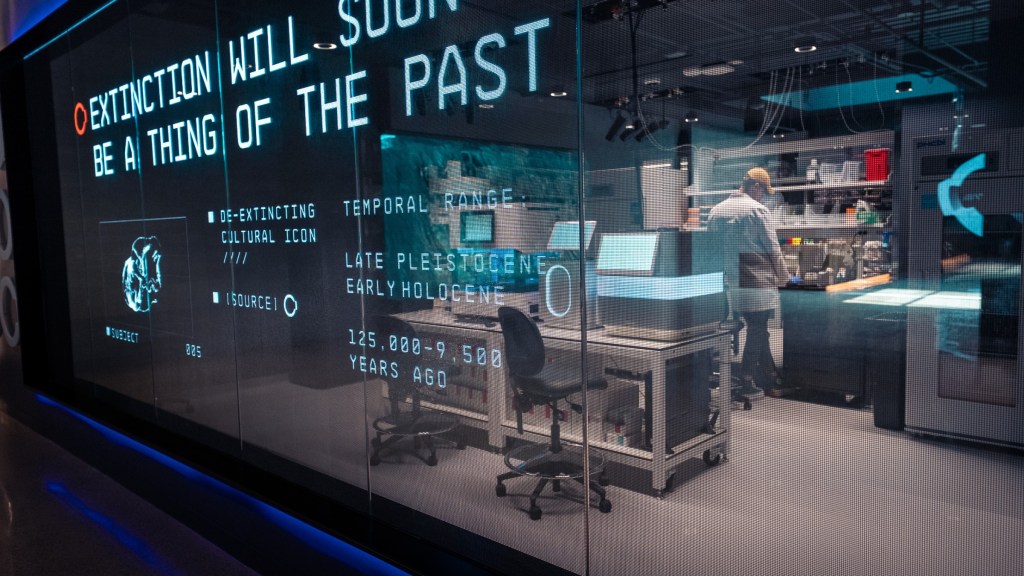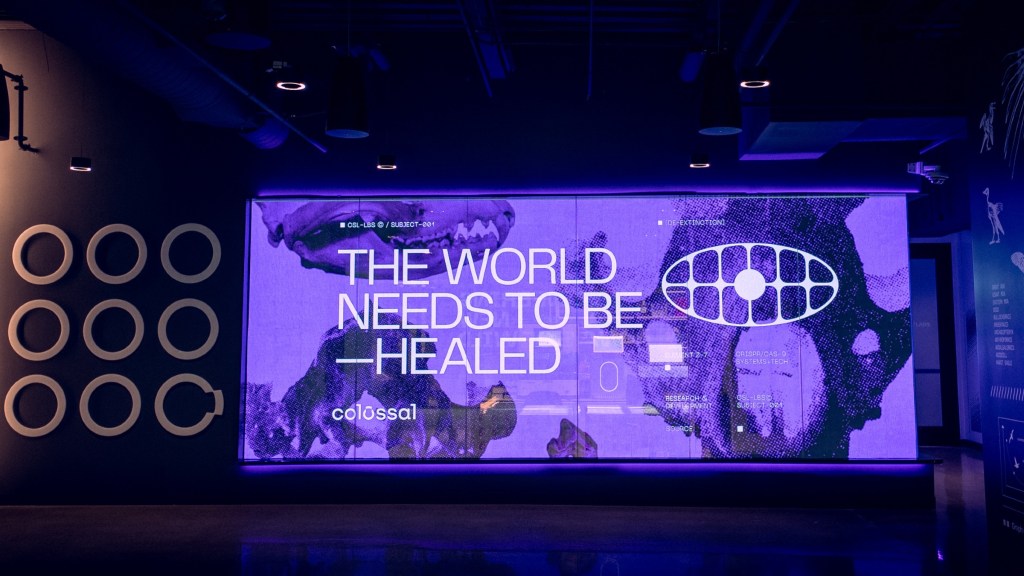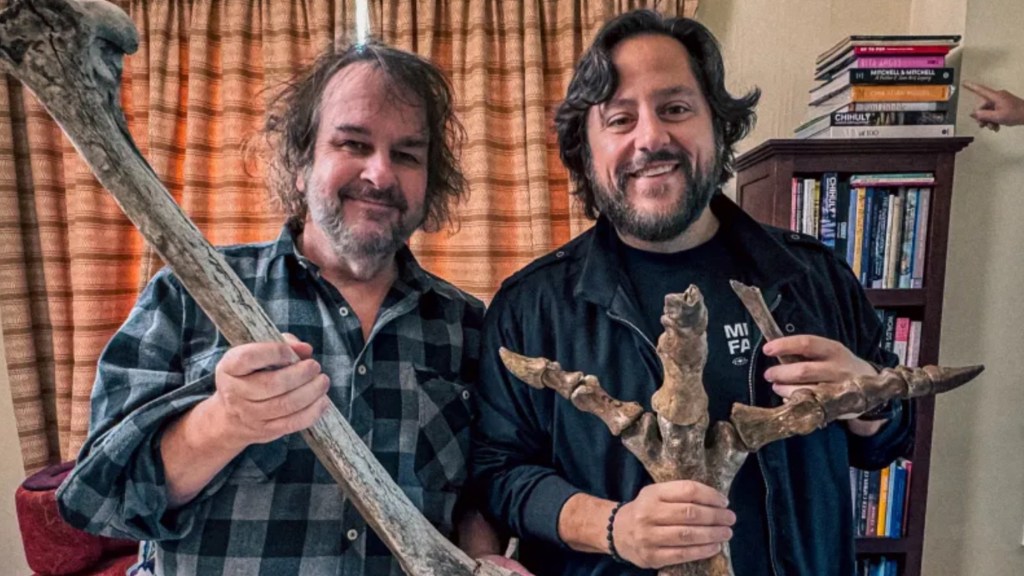A little over 30 years ago, dinosaurs walked the Earth again thanks to Steven Spielberg’s Jurassic Park, and since then, the horror sci-fi franchise has raked in billions of dollars at the worldwide box office. In a far more intangible way, the original dino-blockbuster is also part of why a real-life company is pioneering deextinction technology, or certainly why you’ve probably heard of their work. In recent years, Colossal Biosciences and CEO Ben Lamm have made news for their work attempting to de-extinct woolly mammoths and for bringing dire wolves back from extinction after 10,000 years. Or at least bio-engineering normal wolves to carry dire wolf traits (which is in no way simple).
Videos by ComicBook.com
Given sci-fi cinema’s fascination with humanity’s burning need for discovery (and the usually grim consequences, as the Jurassic Park movies repeatedly show), Colossal could probably be forgiven for ignoring the parallels. But for Lamm, it’s part of a campaign of awareness, and the company has gone from being told by a worried PR firm to never, ever say Jurassic Park in interviews to embracing it. ComicBook’s Chris Killian was recently invited to the company’s lab in North West Dallas to find out just how deep the comparison goes, and in the process was given an answer to a question that has baffled some of the greatest minds of our time: could anyone actually make a Pokémon?

According to Lamm, it wouldn’t necessarily be a question of whether they could, as Jeff Goldblum’s Ian Malcolm feared, would whether they should. Score one for real life over the sci-fi world. In short, “from a genome engineering perspective and an embryology perspective”, the technology could theoretically do it, at least in terms of the iconic Pokémon’s look:
“I don’t know if it’d be us, but do I think that humanity will have the ability to engineer the Pikachus of the world? I think so. I do from a technology perspective. But… what is the purpose of it, right? Do I think making a Pikachu has a conservation purpose?
No, but if you had an educational company that made a Pikachu and you did it in partnership with Pokémon and you got 50 million kids excited about science, because they learned the genetic process of how to make a Pikachu… do I think there’s value in that? Yes. Are we doing it? No, are we gonna do it? No, let’s get through dodos and
thylacine, and mammoths. But I do think that we’re learning about striping patterns… Look, we took coat colors and hair phenotypes from million-year-old mammoths and put them on to mice, right? And do I think you could learn about how to make a yellow chinchilla that’s got you know tiger-like stripes? Then yeah, you could, from a genome genetic engineering perspective. We will definitely have the technology. But it’s like, what is the purpose, right?”
No news yet on whether the Pikachu chinchillas will have electric powers. The lab visit also gave ComicBook more insight into what Colossal’s team is focused on next. No dinosaurs after the dire wolves, but more extinct animals.
Colossal’s Next Project After The Dire Wolves

Pokémon aside, Colossal is committed to conservation – something that can get lost in the more rock and roll coverage of cloned Pikachus and Jurassic Park analogies. More specifically, they’re focusing attention on a fairly recent extinction – the thylacine, the wolf-like Tasmanian tiger, which went extinct somewhere between 1936 and the late 1940s. “There were some rumors… older sightings like it’s like the Bigfoot of Tasmania.” Chris also asked Ben about recently extinct species he’d like to work on:
“The one we’re not working on – so I don’t want to get people excited – is a Carolina parakeet. It’s a really cool bird. We have two big avian projects right now, right? We have the dodo and the moa, so we’re not gonna add another one now, but I could see in the future us thinking about that, and it’s a recent extinction.”
Whatever species are focused on, Lamm is committed to a very un-John Hammond-like trajectory. He talks with great enthusiasm and energy about the future – about the need for more people to take greater moonshots, rather than just investing in the next social media platform, and about Colossal’s role in things. He says comic book companies have reached out about working with them, and films about developing projects, and fundamentally feeding the excitement for the work they’re doing.
But at the heart of it all is the mantra ComicBook saw emblazoned on a big screen at the lab: “The World Needs To Be Healed.” For Lamm, the way to achieve that is to “do things really thoughtfully”, always considering how “you create the best educational experience where a kid and a parent leave and they’re like, ‘oh my gosh, I want to be a scientist and I want to be a biologist’. He says the objective has to be making “an actionable connection to conservation while inspiring them using genetics and in extinct species. But not doing it in a transactional way where it feels like you’re paying to see animals. How do we put science on display, but not animals in this way?”
It’s not hard to see the same sort of wonder that Hammond expressed in his infamous flea circus speech in Jurassic Park. But Lamm’s commitment to science suggests the commodification of his work won’t go the way of the most famous dinosaur franchise in Hollywood.
Colossal Use Hollywood Talent To Their Advantage

Lamm also spoke about the company’s working relationships with talent like George RR Martin, Peter Jackson, and Godzilla: King of the Monsters director Mike Dougherty. That includes some of them being investors in Colossal. The important thing they’ve imparted is the “power of storytelling,” which is increasingly important for scientific stakeholders. If you can get buy-in, you have a captive audience, and Colossal clearly has good “content”. Just ask Peter Jackson, who played a big part in the roll-out of the dire wolf news a few months back:
“When we were in Peter’s house in Wellington, we were already working on the Giant Moa project. We plugged in the computer, and Mike showed him the first dire wolf howls and he immediately said, ‘You need to lead with that.’ He teared up and said ‘This is the first time anyone’s heard these howls in 10,000 years. That should be the first thing everyone sees.’ And he wasn’t thinking about selling it, he was thinking about the emotional reaction.”
“I think a lot of these people get typecast: they’re a movie producer or they’re a director or they’re an actor… But they’re insatiably curious, right? A lot of these people are at the peaks of their careers. Big imaginations – and, Peter has said this publicly, so I don’t mind saying this – he said, ‘My day job is movies and I love it. That’s my job. But this is my passion, and that’s pretty awesome. When you have that, it’s cool.’”
You can find even more information on Colossal’s work on Colossal’s official website.








